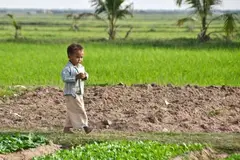Biodiversity and nutrition: New evidence links ecosystem health to children’s diets
Key takeaways
- Children’s diet quality improves near mixed forest–agriculture landscapes, peaking about 80 km from protected areas.
- Indigenous communities near protected areas consume more vitamin A–rich foods, highlighting the nutritional value of traditional land use.
- Researchers urge conservation strategies to integrate agriculture and forest management to support biodiversity and local nutrition.
New research has found that protected areas prevent biodiversity loss have created unintended impacts on the diets of children living nearby.
Researchers from Pennsylvania State University, US, analyzed data on children’s diets in Cambodia and Myanmar. The quality of the diet increases with the distance from protected areas up to 80 km, then declines.
Published in the British Ecological Society’s journal, People and Nature, the study finds that children in Indigenous areas consumed more vitamin-A-rich foods, which were absent in non-Indigenous regions.
The researchers call on conservation strategies to acknowledge mixed land uses, instead of strictly separating agriculture and forests.
Align conservation and public health
The researchers explain that vitamin A is essential for children, as it supports growth and immune defense. A lack of this vitamin can cause night blindness and increase the risk of illness and death, warns the WHO. Examples include measles and diarrheal disease.
The researchers urge that knowing how proximity to protected areas links to vitamin A can help conservation and public health planners align strategies. Study lead Lilly Zeitler, a doctoral candidate in the Department of Geography, adds that this would aid nations in expanding protection goals.

“In some places, local communities rely directly on nearby lands and ecosystems for food. They manage these food systems under customary tenure — local rules enforced by tradition and social norms rather than formal laws.”
“Creating protected areas can disrupt that customary tenure, with negative effects on how people get food. Alternatively, tourism can boost local incomes near protected areas in ways that alter households’ food purchasing patterns. Despite these clear conceptual links between protected areas and local diets, these relationships remain poorly understood,” she flags.
Agroecological matrix
In Cambodia and Myanmar, large shares of protected land overlap with Indigenous territories. This enabled researchers to compare patterns and contrast approaches to Indigenous rights.
 Children’s diets benefit from diverse landscapes near protected forests in Cambodia and Myanmar.“A cross-country comparison is interesting to see whether there are different relationships between protected areas, diets, and Indigeneity in these two very different contexts,” says Zeitler.
Children’s diets benefit from diverse landscapes near protected forests in Cambodia and Myanmar.“A cross-country comparison is interesting to see whether there are different relationships between protected areas, diets, and Indigeneity in these two very different contexts,” says Zeitler.
Data collected between 2014 and 2015–16 came from caregivers of 2,899 children aged 6–59 months. Researchers asked them about what children did the previous day and then matched each community to the nearest protected area to measure the distance to the boundary.
Researchers also examined dietary diversity and whether children consumed pulses or vitamin A-rich fruits and vegetables across the distance. They adjusted for household wealth, maternal education, breastfeeding, season, market access, rainfall, elevation, and proximity to water and forest cover as well.
Results reveal a non-linear pattern where the highest dietary diversity was within 80 km of protected areas, where landscapes mix forests and agriculture.
“For our analytic sample, mid-distances from protected areas had about a third of forest cover,” adds Zeitler.
“One-third forest cover indicates a mix of different land uses at an 80-km distance, including forest cover and agriculture, in what other researchers call an ‘agroecological matrix.’ These mixed landscapes appear to be associated with higher dietary diversity among young children.”
In Indigenous population areas within the 80 km, children had higher chances of eating vitamin-A-rich foods and different distance patterns for pulses.
“We think this is because common vitamin-A-rich fruits and vegetables in the region, such as mango, passionfruit, sweet potato, and squash, are often grown in mixed landscapes,” explains Zeitler.
“Mixed landscapes with swiddens and home gardens might be more important sources of vitamin-A-rich fruits and vegetables for Indigenous populations in the region.”
Conservation and Indigenous rights
Zeitler notes that the study can inform conservation planning for countries targeting the UN’s Kunming-Montreal Global Biodiversity Framework’s 30-by-30 target. The goal is to conserve at least 30% of land, inland waters, and oceans by 2030, especially focused on effective management and Indigenous rights.
 Mixed forest–agriculture zones near protected areas support biodiversity and healthier diets for Indigenous children.“Our results can inform conservation efforts seeking to minimize negative relationships between protected areas and local populations’ health and diet quality,” she says.
Mixed forest–agriculture zones near protected areas support biodiversity and healthier diets for Indigenous children.“Our results can inform conservation efforts seeking to minimize negative relationships between protected areas and local populations’ health and diet quality,” she says.
“The results indicate that an ‘agroecological matrix’ approach to conservation, rather than the binary ‘land sparing’ model that separates people and agriculture from forests, could support local diet quality in some contexts.”
According to Zeitler, further research should explore and elaborate on the identified patterns of children’s diet quality near protected areas.
“Because this study is based on secondary pre-existing anonymized datasets, we could not interview people in Indigenous and non-Indigenous population areas on why their consumption of some food groups differed at different distances from protected areas, for instance,” she explains.
Casual inferences were not drawn, as the data are snapshots rather than tracking changes in the long term.
Her team also did not link country-level differences between Cambodia and Myanmar to specific policies due to a lack of longitudinal data and additional analyses.
Nonetheless, Zeitler hopes the finding can inform conservation and health discussions: “I hope this research will stimulate debate and dialogue among conservationists and policymakers on the relationships between protected areas and local diets.”
“The perceived need to separate forest and agriculture for conservation can be challenged by recognizing the importance of mixed land use systems for local diets, especially among Indigenous populations in some parts of the world.”
















